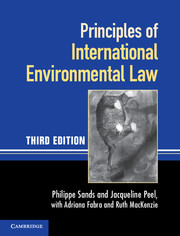Book contents
- Frontmatter
- Contents
- Foreword
- Preface and acknowledgments to the first edition
- Preface and acknowledgments to the second edition
- Preface and acknowledgments to the third edition
- Table of cases
- Table of treaties and other international instruments
- Abbreviations
- Part I The legal and institutional framework
- Part II Principles and rules establishing standards
- Part III Techniques for implementing international principles and rules
- Part IV Linkage of international environmental law and other areas of international law
- 18 Human rights and armed conflict
- 19 International trade and competition
- 20 Foreign investment
- 21 Future developments
- Index
- References
19 - International trade and competition
from Part IV - Linkage of international environmental law and other areas of international law
Published online by Cambridge University Press: 05 June 2012
- Frontmatter
- Contents
- Foreword
- Preface and acknowledgments to the first edition
- Preface and acknowledgments to the second edition
- Preface and acknowledgments to the third edition
- Table of cases
- Table of treaties and other international instruments
- Abbreviations
- Part I The legal and institutional framework
- Part II Principles and rules establishing standards
- Part III Techniques for implementing international principles and rules
- Part IV Linkage of international environmental law and other areas of international law
- 18 Human rights and armed conflict
- 19 International trade and competition
- 20 Foreign investment
- 21 Future developments
- Index
- References
Summary
INTRODUCTION
The integration of economic and environmental aspects of international law has been an important aspect of international environmental law particularly since UNCED. Such integration was prompted in part by considerations of the relationship between differing environmental standards and economic competitiveness. Principle 4 of the Rio Declaration reflects this interdependence, providing that ‘in order to achieve sustainable development environmental protection shall constitute an integral part of the development process and cannot be considered in isolation from it’. The theme of integration was central to the preparations for UNCED. Agenda 21 recognised that the international economy should provide a ‘supportive international climate for achieving environment and development goals’, and identified the following as objectives for the international community:
making trade and the environment mutually supportive;
encouraging macroeconomic policies conducive to environment and development; and
providing adequate financial resources to developing countries and dealing with international debt.
This chapter considers the international legal aspects of the first two of these issues: the relationship between international trade and environmental protection, and the application of international rules of competition law to environmental issues. In Chapter 20, other aspects of the relationship between international economic law and environmental protection are addressed, namely, the relationship between rules of international law for the promotion of foreign investments and the protection of the environment.
- Type
- Chapter
- Information
- Principles of International Environmental Law , pp. 799 - 868Publisher: Cambridge University PressPrint publication year: 2012



